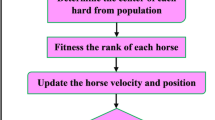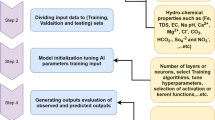Abstract
Depletion of groundwater resources is nowadays being discussed as one of the most significant challenges in this field. Thus, simulation of the available groundwater resources seems necessary for taking reliable management measures for the plains. In the present study, a combination of various metaheuristic algorithms including feed-forward artificial neural network (ANN), the algorithm of innovative gunner (AIG), and black widow optimization (BWO) algorithm was employed to simulate the groundwater of the Selseleh plain located in the southwest of Iran during the period 2008–2018 on a monthly time scale. Furthermore, chicken swarm optimization (CSO) was adopted to optimize the weight coefficients. The data were divided with 70% being used for training purpose and the remaining 30% for test validation. Different statistical indices including the coefficient of determination (R2), root-mean-square error (RMSE), mean absolute error (MAE), Nash–Sutcliffe efficiency (NSE) coefficient, and percentage of bias (PBIAS) were utilized for evaluation of the efficiency of modeling. The results illustrated that all the three hybrid models had better results in combinatory patterns. Moreover, the evaluation criteria suggested that among all the applied models, the ANN-AIG model was the only one possessing all statistical indices (e.g., R2 = 0.964–0.995, RMSE = 0.273–0.71 m, MAE = 0.219–0.059 m, NSE = 0.886–0.978, and PBIAS = 0.002–0.001) in the validation stage. In a nutshell, this study suggested that among all the recommended hybrid models, ANN-AIG, ANN-BWO, and ANN-CSO reduced the simulation error compared to the standalone ANN model with (12.78–20.26)%, (10.13–17.61)%, and (9.27–1675)%, respectively.










Similar content being viewed by others
Availability of data and material
The data and material availability will be made available to researchers after receiving the email.
Code availability
The code availability will be made available to researchers after receiving the email.
References
Abdullah AAA, Alrashed M, Soltanpour Gharibdousti M, Goodarzi L, de Raquel O, Enio P, Bandarra F (2018) Effects on thermophysical properties of carbon based nanofluids: experimental data, modelling using regression, ANFIS and ANN International. J Heat Mass Transf 125:920–932. https://doi.org/10.1016/j.ijheatmasstransfer.2018.04.142
Adamowski J, Chan H (2011) A wavelet neural network conjunction model for groundwater level forecasting. J Hydrol 407(1–4):28–40. https://doi.org/10.1016/j.jhydrol.2011.06.013
Alizadeh MJ, Shabani A, Kavianpour MR (2017) Predicting longitudinal dispersion coefficient using ANN with metaheuristic training algorithms. Int J Environ Sci Technol 14:2399–2410. https://doi.org/10.1007/s13762-017-1307-1
ASCE (1993) Criteria for evaluation of watershed models. J Irrig Drain Eng 119(3):429–442. https://doi.org/10.1061/(ASCE)0733-9437(1993)119:3(429)
Ashmaul Husna NE, Hefzul bari S, Shouroy H, Rahman T (2016) Ground water level prediction using artificial neural network. Int J Hydrol Sci Technol 6(4):371–381. https://doi.org/10.1016/j.jhydrol.2004.12.001
Barzegar R, Alami MT, Adamowski J (2021) Coupling a hybrid CNN-LSTM deep learning model with a boundary corrected maximal overlap discrete wavelet transform for multiscale Lake water level forecasting. J Hydrol. https://doi.org/10.1016/j.jhydrol.2021.126196
Chai T, Draxler RR (2014) Root mean square error (RMSE) or mean absolute error (MAE)?—Arguments against avoiding RMSE in the literature. Geosci Model Dev 7:1247–1250
Chen ST, Yu PS (2007) Real-time probabilistic forecasting of flood stages. J Hydrol 340:63
Dabanlı İ, Şen Z (2018) Precipitation projections under GCMs perspective and Turkish Water Foundation (TWF) statistical downscaling model procedures. Theoret Appl Climatol 132:153–166. https://doi.org/10.1007/s00704-017-2070-4
Duie Tien B, Khosravi K, Tiefenbacher J, Nguyen H, Kazakis N (2020) Improving prediction of water quality indices using novel hybrid machine-learning algorithms. J Sci Total Environ 721. https://doi.org/10.1016/j.scitotenv.2020.137612
Ebtehaj I, Bonakdari H (2014) Performance evaluation of adaptive neural fuzzy inference system for sediment transport in sewers. Water Resour Manag 28:4765–4779. https://doi.org/10.1007/s11269-014-0774-0
Engelbrecht AP (2007) Computational intelligence: an introduction. Wiley, Hoboken
Gupta HV, Sorooshian S, Yapo PO (1999) Status of automatic calibration for hydrologic models: comparison with multilevel expert calibration. J Hydrol Eng 4(2):135–143. https://doi.org/10.1061/(ASCE)1084-0699(1999)4:2(135)
Haykin S (1994) Neural networks: a comprehensive foundation, 1st edn. Prentice Hall PTR, Upper Saddle River
Hayyolalam V, Pourhaji Kazem AA (2020) Black widow optimization algorithm: a novel meta-heuristic approach for solving engineering optimization problems. Eng Appl Artif Intell. https://doi.org/10.1016/j.engappai.2019.103249
Kardan Moghaddam H, Ghordoye Milan S, Kayhomayoon Z, Rahimzadeh Kivi Z, Arya Azar N (2021) The prediction of aquifer groundwater level based on spatial clustering approach using machine learning. Environ Monit Assess. https://doi.org/10.1007/s10661-021-08961-y
Kashani M, Ghorbani MA, Shahabi M, Naganna SR, Diop L (2020) Multiple AI model integration strategy—application to saturated hydraulic conductivity prediction from easily available soil properties. Soil Tillage Res 196:449–458. https://doi.org/10.1016/j.still.2019.104449
Kesgin E, Agaccioglu H, Dogan A (2020) Experimental and numerical investigation of drainage mechanisms at sports fields under simulated rainfall. J Hydrol 580:251–264. https://doi.org/10.1016/j.jhydrol.2019.124251
Khosravi K, Nohani E, Maroufinia E, Pourghasemi HR (2016) A GIS-based flood susceptibility assessment and its mapping in Iran: a comparison between frequency ratio and weights of evidence bivariate statistical models with multi-criteria method. Nat Hazards 83(2):1–41
Khosravi K, Pham BT, Chapi K, Shirzadi A, Shahabi H, Revhaug I, Prakash I, Tien Bui D (2018) A comparative assessment of decision trees algorithms for flash flood susceptibility modeling at Haraz watershed, northern Iran. Sci Total Environ 627:744–755. https://doi.org/10.1016/j.scitotenv.2018.01.266
Kisi O, Dailr AH, Cimen M, Shiri J (2012) Suspended sediment modeling using genetic programming and soft computing techniques. J Hydrol 450:48–58. https://doi.org/10.1016/j.jhydrol.2012.05.031
Legates DR, McCabe GJ (1999) Evaluating the use of goodness-of-fit” measures in hydrologic and hydroclimatic model validation. Water Resour Res 35:233–241. https://doi.org/10.1029/1998WR900018
Lin JY, Cheng CT, Chau KW (2006) Using support vector machines for long-term discharge prediction. Hydrolog Sci J 51:599–612. https://doi.org/10.1623/hysj.51.4.599
Lo Conti F, Hsu KL, Noto LV, Sorooshian S (2014) Evaluation and comparison of satellite precipitation estimates with reference to a local area in the Mediterranean Sea. Atmos Res 138:189–204. https://doi.org/10.1016/j.atmosres.2013.11.011
McCulloch W, Pitts W (1943) A logical calculus of ideas immanent in nervous activity. Bull Math Biophys 5(4):115–133. https://doi.org/10.1007/BF02478259
Melesse AM, Ahmad S, McClain ME, Wang X, Lim YH (2011) Suspended sediment load prediction of river systems: an artificial neural network approach. Agric Water Manag 98:855–866. https://doi.org/10.1016/j.agwat.2010.12.012
Meng X, Liu Y, Gao X, Zhang H (2014) A new bio-inspired algorithm: chicken swarm optimization. In: International conference in swarm intelligence, vol 124, pp 86–94
Minsky M, Papert S (1969) Perceptrons: an introduction to computational geometry. MIT Press, Cambridge
Mohammadi Golafshani E, Behnood A, Arashpour M (2020) Predicting the compressive strength of normal and high-performance concretes using ANN and ANFIS hybridized with grey wolf optimizer. Construct Build Mater. https://doi.org/10.1016/j.conbuildmat.2019.117266
Moosavi V, Vafakhah M, Shirmohammadi B, Behnia N (2013) A wavelet-ANFIS hybrid model for groundwater level forecasting for different prediction periods. Water Resour Manag 27(5):1301–1321. https://doi.org/10.1007/s11269-012-0239-2
Musie M, Sen S, Srivastava P (2019) Comparison and evaluation of gridded precipitation datasets for streamflow simulation in data scarce watersheds of Ethiopia. J Hydrol 579:168–177. https://doi.org/10.1016/j.jhydrol.2019.124168
Nagelkerke NJD (1991) A note on a general definition of the coefficient of determination. Biometrika 68:224–254. https://doi.org/10.1093/biomet/78.3.691
Nagy H, Watanabe K, Hirano M (2002) Prediction of sediment load concentration in rivers using artificial neural network model. J Hydraul Eng 128:558–559. https://doi.org/10.1061/(ASCE)07339429(2002)128:6(588)
Nash JE, Sutcliffe JV (1970) River flow forecasting through conceptual models: part 1. A discussion of principles. J Hydrol 10(3):282–290. https://doi.org/10.1016/0022-1694(70)90255-6
Nourani V, Alami MT, Aminfar MH (2009) A combined neural-wavelet model for prediction of Ligvanchai watershed precipitation. Eng Appl Artif Intell 22(2):466–472. https://doi.org/10.1016/j.engappai.2008.09.003
Pengxin D, Zhang M, Bing J, Jia J, Zhang D (2019) Evaluation of the GSMaP_Gauge products using rain gauge observations and SWAT model in the Upper Hanjiang River Basin. Atmos Res 219(4):153–165
Pincus R, Batstone CP, Hofmann RJP, Taylor KE, Glecker PJ (2008) Evaluating the present-day simulation of clouds, precipitation, and radiation in climate models. J Geophys Res Atmos 113(D14):1–10. https://doi.org/10.1029/2007JD009334
Rajaee T, Mirbagheri SA, Zounemat-Kermani M, Nourani V (2009) Daily suspended sediment concentration simulation using ANN and neuro-fuzzy models. Sci Total Environ 407:4916–4927. https://doi.org/10.1016/j.scitotenv.2009.05.016
Ramiro T, Cerro GD, Subathra MSP, Kumar NM, Verrastro S, George T (2020) Modelling the daily reference evapotranspiration in semi-arid region of South India: a case study comparing ANFIS and empirical models. Inf Process Agric 24:522–533. https://doi.org/10.1016/j.inpa.2020.02.003
Rastegaripour F, Saboni MS, Shojaei S (2019) Simultaneous management of water and wastewater using ant and artificial neural network (ANN) algorithms. Int J Environ Sci Technol 16:5835–5856. https://doi.org/10.1007/s13762-018-1943-0
Senthil Kumar AR, Sudheer KP, Jain SK, Agarwal PK (2004) Rainfall–runoff modeling using artificial neural network: comparison of networks types. Hydrol Process 19(6):1277–1291. https://doi.org/10.1002/hyp.5581
Sevat E, Dezetter A (1991) Selection of calibration objective functions in the context of rainfall-runoff modeling in a Sudanese savannah area. Hydrol Sci J 36(4):307–330. https://doi.org/10.1080/02626669109492517
Sigaroudi AE, Nayeri ND, Peyrovi H (2013) Antecedents of elderly home residency in cognitive healthy elders: a qualitative study. Glob J Health Sci 5(2):2000–2007
Sreekanth PD, Geethanjali N, Sreedevi PD, Shakeel A, Ravi Kumar N, Kamala Jayanthi PD (2009) Forecasting groundwater level using artificial neural networks. Curr Sci 96(7):99–112
Steyl G (2009) Application of artificial neural networks in the field of geohydrology. University of the Free State, South Africa
Talebizadeh M, Moridnejad A (2011) Uncertainty analysis for the forecast of lake level fluctuations using ensembles of ANN and ANFIS models. Expert Syst Appl 38:4126–4135. https://doi.org/10.1016/j.eswa.2010.09.075
Taylor KE (2001) Summarizing multiple aspects of model performance in a single diagram. JGR Atmos 106:7183–7192. https://doi.org/10.1029/2000JD900719
Victor H, Chi Q, Almorox J, Ibrakhimov M, Saito L (2017) Estimating daily global solar radiation by day of the year in six cities located in the Yucatán Peninsula, Mexico. J Clean Prod 141. https://doi.org/10.1016/j.jclepro.2016.09.062
Wehner MF (2013) Very extreme seasonal precipitation in the NARCCAP ensemble: model performance and projections. Clim Dyn 40(1–2):59–80. https://doi.org/10.1007/s00382-012-1393-1
Yin J, Azuara JM, Escriva-Bou A, Liu Z (2021) Bayesian machine learning ensemble approach to quantify model uncertainty in predicting groundwater storage change. Sci Total Environ. https://doi.org/10.1016/j.scitotenv.2020.144715
Zare M, Koch M (2018) Groundwater level fluctuations simulation and prediction by ANFIS- and hybrid Wavelet-ANFIS/fuzzy C-means (FCM) clustering models: application to the Miandarband plain. J Hydro-Environ Res 18:63–76. https://doi.org/10.1016/j.jher.2017.11.004
Ziya Kaya Y, Unes F, Demirci M, Tasar B (2018) Groundwater level prediction using artificial neural network and M5 tree models. Air Water Compon Environ Conf. https://doi.org/10.24193/AWC2018_23
Zouache D, Arby Y, Nouioua F, Abdelaziz F (2019) Multi-objective chicken swarm optimization: a novel algorithm for solving multi-objective optimization problems. Comput Ind Eng 129. https://doi.org/10.1016/j.cie.2019.01.055
Acknowledgements
The authors thank Lorestan Regional Water Company, Iran for participating in the collection of data needed to do the job.
Funding
The University of Lorestan Khorramabad Iran supported our research work (Grant No. 1).
Author information
Authors and Affiliations
Contributions
The authors include Dr. Reza Dehghani and Dr.Hassan Torabi Poudeh consistently participated in the preparation of this article.
Corresponding author
Ethics declarations
Conflict of interest
The authors declare that they have no conflict of interest.
Consent to participate
This study is exempt from Lorestan Regional Water Company. Based on the fact that this type of study is a type of inhuman research and the need for informed consent was waived.
Consent for publication
The author agrees to publish the article in the above publication.
Ethical approval
This article does not contain any studies with human participants or animals performed by any of the authors.
Additional information
Editorial responsibility: Samareh Mirkia.
Rights and permissions
About this article
Cite this article
Dehghani, R., Torabi Poudeh, H. Application of novel hybrid artificial intelligence algorithms to groundwater simulation. Int. J. Environ. Sci. Technol. 19, 4351–4368 (2022). https://doi.org/10.1007/s13762-021-03596-5
Received:
Revised:
Accepted:
Published:
Issue Date:
DOI: https://doi.org/10.1007/s13762-021-03596-5




